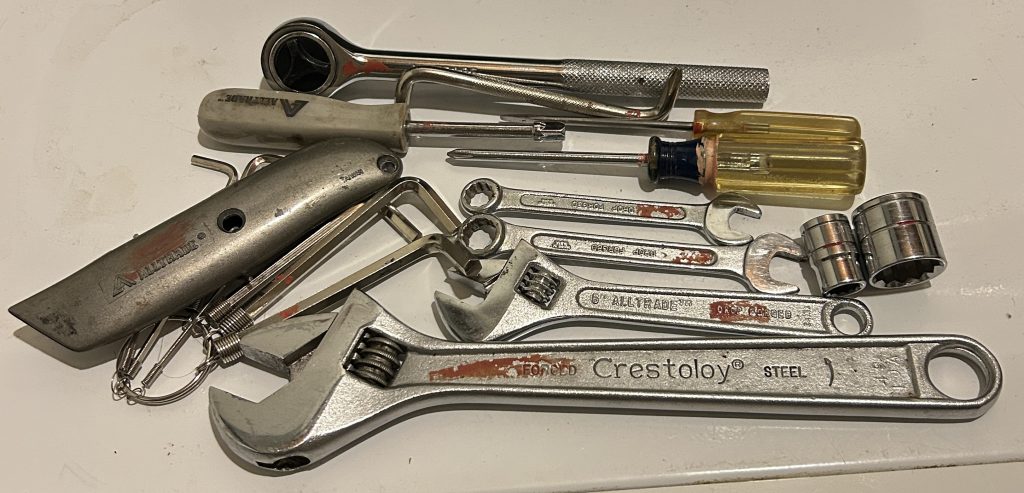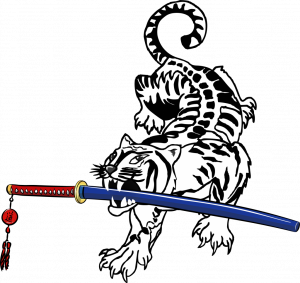 A Bit Of Nail Polish (What’s In Your Tool Box?)
A Bit Of Nail Polish (What’s In Your Tool Box?)
Guest post by 5th Dan Haedong Kumdo student, Christine Keenan —
I came home one day and found my father at the table with a bottle of old nail polish. He was using it to mark the tools he had on the table. When I asked him about it he said that he was marking the tools he was putting together for my . They were being marked to ensure that they stayed with my toolbox, especially if he borrowed them, which he did all the time when I was home. He also purchased new tools that he did not have duplicates of to make sure the basics were covered. Even now he is still giving me things for my toolbox. I also add to my own toolbox and my needs grow and change.
So, what is in your toolbox?
The first part of the toolbox is specific to you. Your personal and private toolbox. My toolbox has my own copy of the forms and drills that I created and keep updating and refining as I learn more. It contains the videos of myself that I use to improve my movements and understanding about myself. It contains all my experiences that I bring to my martial arts. My dance background influences how I move. My work experiences and everything else, also contribute to my martial arts. You find the items in your toolbox that help you to learn your art better. You also find the items that hinder your growth. The items can be the same or different items, like two sides of the same coin. Your knowledge and experience can help in you in some moments and hinder in others. Past and present people in your life influence you as they move in and out of your life. What you read and expose yourself to is also part of the toolbox. You grow and learn, you get insights. You try a direction and sometimes have to backtrack and start down a different one, or what you learn now takes you in a different direction. But everything here is specific to me and shape how I see my training. How I understand what I am learning and continuing to learn from my art, my master, my classmates and students. This part of the toolbox as said above is unique to you and only you. Just like your flairs in forms.
Even with the previous part of the toolbox being private you draw on items in it for the other part of the toolbox. The other part of the toolbox comes from the community. I will talk about that next, but for now we will stick to this middle area. As I said, this is the part that is community toolbox. This is what is shared to the group. Your thoughts and insights that bubble up from the private part of the toolbox. It is the knowledge of your training and experiences. An example is I have seen enough classmates over my 14 years in this art that I know the areas in forms and basics that students will have trouble with. I can help get them through those stages as my master did with me. Like my master I can see areas that are difficult for specific students and can help them as well. I can create drills isolating movements to start with that will help the student work on the issue to improve themselves. The drill might be one from a previous seminar that could help the student start to overcome something that is in their private toolbox. I have different ways to say the same thing to find the one that student will connect to. It might be something the student will understand later as their knowledge grows.
The other part of the toolbox is from the community. Initially your tool box will start with the training tools your master has provided for you, like manuals and videos. The language your school uses, which is the consistency in the terms and their meaning helps instructors teach the students the new forms, or drills. This is like when my father pulled items from his toolbox and gave them to me so that I would be able to start off on the right foot. Once you learn the system of the words you become more teachable and you can teach others. Your Master’s knowledge from his private toolbox is also transmitted in this toolbox. This can be the mistakes he has already made so you don’t make them yourself, you get to make all new mistakes. But this helps the community grow up together. As your master sees and understands more he communicates that. As your classmates and you see more you communicate that. Even if it does not make sense now that does not mean it won’t in the future.
How much you use this toolbox is up to you. How much you contribute to the toolbox is up to you. Do you ask questions in class? Do you use the manuals and videos to help you to keep yourself on track and prevent rework? Do you get help from your master or other classmates, if you are having trouble understanding? Do you use this toolbox to help you get yourself up faster? The next thing you say in class could be a small step or a giant light bulb moment. It could help one student that is struggling or a few. The comment might be something not even related to the martial art but will help someone on their path. Are you using all the resources at your disposal to help you improve?
Author: Master Robert Frankovich
As you read and enjoy the posts on this site, please consider “sharing” them! The “likes” help generate additional readership but “sharing” will help even more! Thank you for your assistance!
If you have questions, please feel free to contact me!


